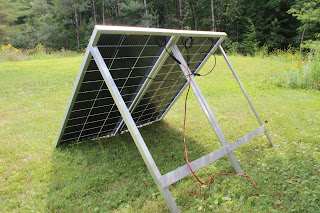Last winter we had a power failure which is something that happens often here in rural Maine due to snow and wind storms, but what was unusual was that my automatic backup generator didn't start. I went out and tried to manually start it and it wouldn't go. Turns out the valves were badly out of adjustment.
While I do have a substantial solar power system, it is grid inter-tied which means that it must power down in the event of a power outage so it cannot feed power back into the grid and harm the line workers. I can't affort a huge whole house battery system like the Tesla Powerwall which would cost over $20,000.
So I was without power for four days, and that was quite tedious to say the least. I had to keep wood stoves going in both my home and workshop to keep them warm and I was melting snow to flush toilets - and also peeing outside as often as practical. I did have an old car battery and a 300 W inverter that I could use to power my phone and a few lights, but without Internet I also didn't have any entertainment other than what I could do on my phone. However, my biggest concern was losing food in my fridge and freezer.

So I purchased a factory reconditioned Ecoflow Delta 2 solar generator for under $600. This amazing device can put out over 1800W to power AC devices like lights, and my refrigerator. It also has multiple USB charging jacks. But more importantly, it can charge from solar, vehicle 12 V power, or AC power from an outlet.

I connected the two solar panels together with large hinges so I could fold them together face-to-face. I then purchased a bunch of aluminum angle and riveted it together to create a tilt stand.
With the panels folded up I can easily move them on a dolly - they weigh over 40 lbs. So I can store them in my workshop and deploy them easily.
To connect the solar panels to the generator I purchased a special 12AWG 25FT Solar to XT60i Cable for that purpose. The orange plug goes into the generator and the black MC4 plugs connect to the solar panels. I wired the two solar panels in series so one just connects to the other then this cable connects to the other remaining ends.
So now I leave the extension cord plugged into the outlet for normal usage, but when the power fails I simply move it over to the generator, turn on the generator, and then deploy the solar panels.
This system gives me a sense of security because my automatic standby generator is old (1200 hours of run-time) and could fail again in the future. While this system does not provide enough power for my well pump, it does give me plenty of power to run my fridge, lights, TV system etc.
In my initial tests at this time of year when there is plenty of sun the solar panels can charge generator in several hours. Then the generator can run the fridge for over 16 hours each day and I could let it coast for the other few hours since I would not be opening the door at night.
If there was not sufficient sun, I could always take the generator over to my car and plug it into the accessory outlet to charge it. My Chevy Bolt EV has over 45 kW of battery-power that I could use sparingly. My automatic backup generator does not provide power to my charging station, but I could go to a public charging station top off the battery in my car if needed.
If I need more battery capacity, I can purchase an ECOFLOW DELTA 2 1024Wh LiFePO4 Expansion Battery for about $500. It's about the same size and shape as the generator and sits on top and would double the capacity of the system.
While this system is not cheap, it does provide real peace of mind. And I could also use the generator to run power tools in locations where there is no power such as up to camp or my backwoods where I might need to run an electric chainsaw.










